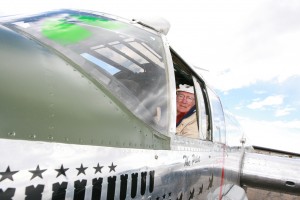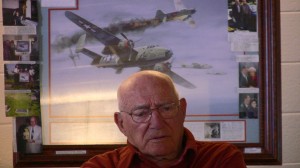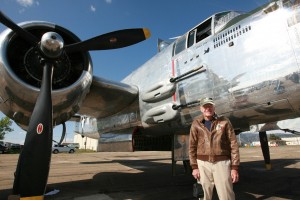By Reggie Paulk
May 10 dawned cold and breezy in Boulder—just the kind of day you don’t want for a fly-in. The 6 a.m. hot air balloon launch wasn’t to be, and many of the aircraft scheduled to attend that Saturday were unable to make it. But the weather didn’t dampen the spirit of the crew of Pacific Prowler, a B-25J bomber owned by the John L. Terry Heritage Foundation.
Along with the bomber, many indoor activities also kept the interest of aviation enthusiasts in attendance. Hosted by Journeys Aviation Inc. and C.M.L. Air Limited, the open house at Boulder Municipal Airport (BDU) featured author Terry Barnhart, Doolittle Raid veteran Col. Bill Bower and Pacific theater veteran Lt. Lynn Daker as guest speakers.
Pacific Prowler made its noisy arrival on Friday afternoon, and after two flybys, taxied onto the ramp. Greeted by a crowd of onlookers, Pacific Prowler sat prominently amongst the much smaller tenants of the field. The flybys attracted the attention of Boulderites everywhere; people arrived throughout the afternoon to get a closer look at the old bomber that had flown over the city.
Capt. Jepp and the Little Black Book
Barnhart is coauthor of “Capt. Jepp and the Little Black Book.” The title refers to the book of drawings Capt. Elrey B. Jeppesen made of the airports along his mail routes. After selling copies to other pilots, Jeppesen started an aviation chart business that would eventually grow to what it is today.
Gaining Jeppesen’s blessing to write the book proved a challenge for Barnhart.
“Somebody said, ‘Why don’t you take him to lunch?’ So I took him to lunch,” Barnhart recalled. “I spent about an hour and a half with him. I heard many stories about flying and barnstorming and those sorts of things. Toward the end of lunch, I said, ‘Captain Jepp, I have this idea. I’d like to write a book about your life. I’m not looking for your approval, but I’d like to have you say that you support that idea.’ He looked at me and changed the subject. He went on to another story. That was the end of the lunch.”
Not to be discouraged, Barnhart kept at it. On his third attempt, he got as close to an approval as he could ever hope.
“I took him to lunch for the third time down at the Willshire Inn, near where he lived,” Barnhart continued. “This time I didn’t wait long into the lunch before I brought up the book. I said, ‘Captain Jepp, I’d really like to do this. I’ve written articles for flying magazines, and I think I can do the job. I’m passionate about it. It won’t cost you anything because I’m volunteering.’ He said, ‘I’ve been flying for 50 years, and I know a lot of people in aviation, and if I was going to have somebody write a book about my life, I don’t know that I would pick you.’ He did it with sort of a smirk on his face and a twinkle in his eye. I got the idea that he was saying, ‘I kind of like the idea, but I’m not going to tell you that I do.'”
And so a book was born.
Doolittle Raid
It’s not often you get to see a war hero, but that was the case that day as Col. Bill Bower sat at the front of the small meeting room speaking to about 15 people in attendance. As he enjoyed a donut provided for the occasion, Bower took questions from the audience and recounted his adventure off the carrier USS Hornet as the number 12 plane in the Doolittle Raid on Tokyo.
“I was 20 when I started flying,” Bower began. “I went to flying school in Randolph and Kelly down in San Antonio, where I finally got my wings. I volunteered. There wasn’t any draft back in those days.”
Bower showed humility as he recounted what the Army Air Corps was looking for in their flying talent.
“You had to qualify to get into flying school, because they were trying to get certain people that had potential,” he said. “I don’t know what I had, but they selected me and I went to flying school.”
Bower has fond memories of flying for the Air Corps.
“It was a great experience to be a military aviator,” Bower said. “I got to fly war-weary airplanes—some before they were weary. I haven’t been allowed to fly for a very long time, but I’d like to, and I bet I could.”
When asked to recount his most memorable experience during the war, Bower quickly responded, “Gettin’ home!”
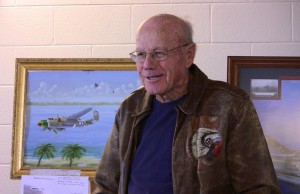
On one of his missions, Lt. Lynn Daker was forced to ditch in the ocean only a few hundred yards from a Japanese-held island. He and his crew were safely rescued.
He then recounted the events of April 18, 1942.
“Fifteen of us followed Gen. Doolittle off of the Hornet,” Bower said. “All of our targets were in or around Tokyo. After bombing Tokyo, we were to go on to China, so we kept going until we ran out of fuel, then we jumped out of the airplanes.”
Little information existed about what they were to expect upon their arrival in China. The only information he and his companions did have is that the Flying Tigers had arrived in China before them. The fact that they had to bail out at night made for a dangerous situation once on the ground.
“We just went to China,” Bower continued. “We got there in the middle of the night and jumped out. I landed gently, folded up my parachute and went to sleep. I got up in the morning, walked about 15 feet and was at the top of a cliff. I thought it was lucky that I didn’t wander around after I landed.”
After encountering some friendly Chinese villagers who knew the whereabouts of some of his compatriots, Bower started his long journey home. Two months later, he was back in the States, a national war hero ready for more.
Pacific theater
At 86 years old, Daker, who flew in the Southwest Pacific in some of the most treacherous conditions of the war, is a man full of energy and enthusiasm. His memory is sharp and he recounts details of his missions with clarity.
Daker still wears his original A2 flying jacket. Sitting on a table in front of him is the original Mae West life preserver he wore as he treaded water waiting for rescue just offshore of a Japanese-held island.
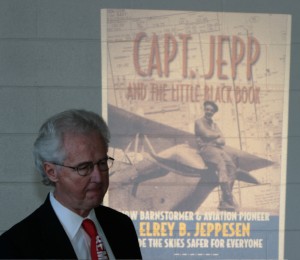
Author Terry Barnhart discussed the difficulties of getting Capt. Jeppesen to approve of Barnhart writing a book about the pilot’s life. His book, “Capt. Jepp and the Little Black Book,” is the result of his efforts.
Out of the 36 missions he flew, Daker took enemy fire 28 times. One of his most memorable flights was a time that the Japanese shot down one of his wingmen.
“The wingman in the second flight was flying a plane I had flown the day before called Mexican Spitfire,” Daker remembered. “He ended up in the water. Now, you were never supposed to talk over the radio. Everything had to be done in Morse code. Here comes his voice over the radio. ‘Come back here and help me, you bastards!’ I’ll never forget that ’til I die. Lloyd Vargo was his name; I can still hear his voice, just as plain as day.”
Daker fared better.
“My right bomb bay doors were hanging down for a while,” Daker said. “Then they flew off. The tires were blown out and the flaps were blown off. There were a million holes in the right wing, and I’m still flying. The guy on the other wing had his ailerons shot out and he was flying with only rudder and elevator.”
The enemy shot down the other plane as it made a circle to go back. Daker went out the next day to look for them, but his compatriots were never found.
Those in attendance at the Boulder Fly-In were treated to a hands-on history lesson that would leave a lasting impression. Our living legends of World War II are becoming fewer by the day, and it’s a rare privilege to hear their stories first-hand.
To see a video of Pacific Prowler’s arrival in Boulder, visit [http://www.reggiepaulk.com/2008/05/see-wwii-b-25-bomber-pacific-prowler-in.html].













